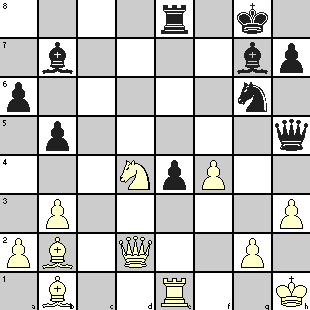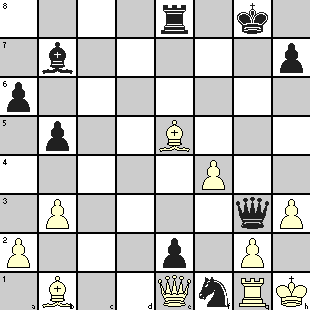We keep bringing this up from time to time because this aspect of chess games occurs quite frequently to influence the course of the game. In Chess Tactics: A protected passed pawn is a passport to win, you were introduced to this aspect and Chess Tactics in Middle Game: Power of the Passed Pawn elaborated on this theme. Chess Tactics in Middle Game: Give up Queens to get Passed Pawns! as also Chess Sacrifice as a Chess Tactics: creating passed pawn showed you the lengths to which a player can go to create a passed pawn to this end. We also showed in Chess Sacrifice as a Chess Tactics: promoting a passed pawn how a player can doggedly pursue the course to promote a pawn successfully.
If you think that I am being overly enthusiastic about the power of a passed pawn, you may take a look at the position shown in the following diagram. This position occurred after 29 moves in a game played between Evgeni Vasiukov and Rashid Nezhmetdinov during tournament held at Kharkov in 1956.
Evgeni Vasiukov (b.1933) became an IM in 1958 and GM in 1961. He won the Moscow Championship six times. He scored victories against many of the notable Russian players like Bronstein, Smyslov, Tal, Petrosian, Keres, Polugaevsky etc. but not against Spassky, Karpov and Korchnoi.
Rashid Nezhmetdinov was introduced to you in Importance of chess strategy – Part 1 and has been featured several times after that.

When you look at the position, who draws your attention first? Isn’t it that tiny passed pawn of Black, physically and metaphorically in the centre of the field? It is already in the focus of the opposing Rooks and Bishops. Otherwise, both players seem to have equal chances though Black Queen and Knight are in slightly more active position to launch attack on the White King. Let us see how everything gets tied up to the progress of that passed pawn. The immediate threats by Black were 30. … e3 31. Rxe3 Rxe3 32. Qxe3 Nxf4 33. Qxf4 Qxh3+ 34. Kg1 Qxg2#.
Here is the saga of the passed pawn:
| 30. | Qe3 | Nh4 | ||
| 31. | Rc1 | Qg6 | ||
| 32. | Rg1 | Bxd4 | Black removed the piece that could help in White’s defense against his plans. |
|
| 33. | Qxd4 | Nf5 | The Knight move freed the pin on e-pawn with a tempo by attacking the Queen. | |
| 34. | Qd1 | e3 | ||
| 35. | Be5 | e2 | White’s best bet was possibly 35. Bxf5 to exchange his inactive Bishop for the troublesome Knight. Instead, White tried to cut-off the Rook support, but the Pawn did not need it! It went ahead chasing the Queen while clearing the line for Black’s Bishop. Of course, the Pawn was taboo because of 36. Qxe2 Ng3+ winning the Queen |
|
| 36. | Qe1 | Ng3+ | The Knight came to support the pawn … |
|
| 37. | Kh2 | Nf1+ | … but the Knight now ventures further with the support of the Pawn! The Pawn ensured that capturing the Knight meant suffering checkmate. |
|
| 38. | Kh1 | Qg3 | White resigned because to tackle the double-threat of 39. … Qh2# or 39. … Qxh3#, he had to exchange the queen through 39. Qxg3 Nxg3+ 40. Kh2 Nf1+. But Black would recover his Queen through Pawn promotion on next move e.g., 41. Kh1 e8=Q or 41. Rxf1 exf1=Q |
Position after Black’s 38th move.

Would you agree with me now? Incidentally, Mikhail Botvinnik, the 6th World Champion had this to say about the winner: “Nobody sees combinations as Rashid Nezhmetdinov”.


One Comment
Yes. When you have the advantage of attack and a passed pawn, your opponent can’t take care of both situations. Sort of reminds me of a fork or a double attack tactic.
Trackbacks/Pingbacks